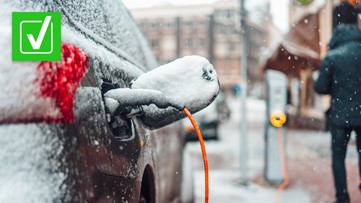A heat wave is scorching parts of the United States, bringing record temperatures to some cities.
During the hot and humid summer months, you may hear your local weather forecaster refer to the “heat index.” That’s led some people online to ask whether the heat index is the same as the actual temperature.
THE QUESTION
Is the heat index the same as the actual temperature?
THE SOURCES
- The National Weather Service (NWS)
- Duane Friend, state master naturalist and climate change specialist with the University of Illinois Extension
- HealthPartners, a nonprofit health care organization in the U.S.
- Massachusetts Institute of Technology (MIT) “Ask an Engineer” feature
THE ANSWER
No, the heat index is not the same as the actual temperature. The heat index is how we get the “feels-like” temperature.
WHAT WE FOUND
The heat index, which is also known as the apparent temperature, is a “measure of how hot it really feels when relative humidity is factored in with the actual air temperature,” according to the National Weather Service (NWS).
That’s why weather forecasters sometimes provide a “feels-like” temperature that’s higher than the actual air temperature during the summer months, Duane Friend, an energy and environmental stewardship educator with the University of Illinois Extension, explains.
When air temperature and relative humidity increase, the “feels-like” temperature increases. For example, if the air temperature is 96 degrees and the relative humidity is 65%, the heat index – or how hot it feels – is 121 degrees.
The NWS has a heat index calculator on its website. However, heat index values are for shady locations and, if a person is exposed to direct sunlight, that “feels-like” temperature can increase by up to 15 degrees, the agency notes on its website.
The heat index is categorized as “dangerous” when feels-like temperatures reach 103 to 124 degrees. This level of heat can lead to heat cramps or heat exhaustion. Heatstroke is also a risk with prolonged exposure to heat or physical activity.
Though the air temperature isn’t actually hotter when the humidity is higher, it feels that way because our bodies can’t cool themselves off as effectively, HealthPartners explains in a blog post.
When temperatures soar in the summer, we sweat. The evaporation of those sweat droplets helps to cool down the body, according to MIT’s “Ask an Engineer” feature.
Sweat evaporates quickly on dry days, meaning it carries heat away from the body faster. But, on humid days, sweat doesn’t evaporate as easily since the air is already full of water vapor.
“Sweat rests on our skin, unable to evaporate into the air,” Mary Benjamin, M.D., an emergency medicine doctor in Minnesota, told HealthPartners. “As a result, our bodies continue to sweat and sweat – but feel no relief. Ultimately, high humidity throws the body into overdrive to cool itself.”
To keep yourself safe in the heat and humidity, HealthPartners recommends staying hydrated by drinking fluids before you get thirsty, easing up on strenuous outdoor activities, wearing loose-fitting and breathable clothing, and taking breaks in the air conditioning.













